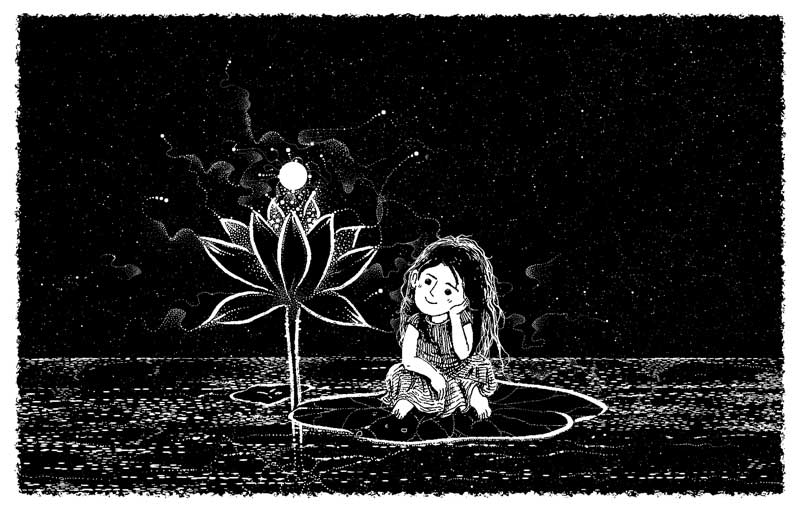07 Dez Dreams are the workshop of spiritual life
Autor: Ortrud Grön
Kategorie: Psychologie
Ausgabe Nr: 81
Dies ist die englische Übersetzung eines ursprünglich auf Deutsch erschienenen Beitrags. Klick hier, um ihn auf Deutsch zu lesen!
What dreams can tell us about our lives
We dream, but only when we understand the dream language do we realise that we are being dreamed. Who speaks to us in our dreams and how can the language of dreams be unravelled and interpreted? The author, a dream researcher, dedicates herself to these questions and reveals how an inner instance within us communicates with us through the sometimes surreal and provocative images of our dreams and wants to show us a way by on the one hand living out our inherent desires and on the other hand leading a life in harmony with life itself.
An old legend has it, that a young man had a dream:
Behind a counter he saw an angel.
Hastily he asked him: „What are you selling, sir?“
The angel gave him a friendly answer: „Anything you want.“
The young man said: „Then I would like:
- a happy marriage that will remain happy until the end of our lives,
- good friends who accompany us on the path of life,
- Children who develop well and whom we enjoy,
- a company that is always successful,
- and, and, and…“
Then the angel said to him, „Excuse me, young man, you have misunderstood me. We’re not selling fruit here, we’re just selling the seed.“
This legend says that we get the seeds from God – but
the gardener who makes them germinate, who nurtures and cares for the plants - we are supposed to be ourselves.
We are to understand our being as the garden in which we grow plants from the seed that God gives us, which blossom and bear fruit.
Our homeland is the love with which we track down the still hidden life within us. But every human being has to go through his own door. Life opens to each person the spaces that he can fill with life.

The tree as the symbol
The great symbol in all myths and religions for how to understand life is the tree. A tree lives on water, air, earth and sunlight. Let us take a closer look at these four forces in their parable meaning for the becoming of man.
- The sun, around which we circle, challenges us every day anew to search for light and warmth within ourselves. For in the sun there is a constant process of harmonisation in which restless hydrogen is transformed into the peaceful noble gas helium.
- In the constant clarification process of the water, the necessary clarification processes of the feelings are reflected, which we humans need, in order to find out from contradictions between dissatisfaction and satisfaction.
- For this we need the oxygen of the air, so that we can deal with contradictions mentally and find new ideas on how we can shape our lives. The airspace points to the liberations to be developed for this purpose.
If you would like to learn more about the four forces, you can order the complete article as a pdf below.
That’s what one of my dreams said:
There is no process in nature that does not reflect the laws that man must obey if he wants to be happy.
My love has always been for the story of the Tree of Knowledge and the Tree of Life in the creation story of the Old Testament. Just as the dream with sensual expressiveness finds the shortest way to provocatively hide conflicts in pictures, so the story of Eve and the serpent hides its meaning for us to find out for ourselves.
Despite the taboo, Eva decides to give in to her desire and bite the apple. She renounces security. She follows the snake, the urge for life and the desire of her heart to distinguish good from evil. One of Dorothee Sölle’s poems so intimately expresses the essence of the tree:
„I your tree …
You dreamt me God
How to practice the upright gait
and kneel down learn more beautiful than i am now happier than i dare freer than allowed with us
Don’t stop dreaming, God.
I don’t want to stop remembering
that I am your tree planted by the streams of life.“
In its vulnerability, our childhood has the deep meaning that we as adults should overcome the fears we have suffered by consciously dissolving the protective attitudes that restrict our desire for freedom.
The dreams help us. They are dramatic poems, our difficulty to mature. What should mature in us? By overcoming fears we gain new consciousness for the liveliness of life.
Perhaps we still behave shyly and anxiously like a lamb seeking protection in the herd. Maybe we are prone to aggression like a crocodile that shreds its prey with its pointed teeth. Or like an antelope that flees as soon as it feels danger.
But perhaps we already love to live openly in the savannah like a lion, without fear of being attacked.
Animals describe our emotional behaviour in dreams, the incredible variety of insects, marine animals, reptiles, mammals and birds of all kinds reflect our own behaviour with their respective peculiarities.
Childhood is often marked by education in perfectionism and diligence. Then ants often appear as actors in our dreams. Ants work on an assembly line and do not lead an individual life.
Slowly I understood that it is about finding the lightness of being and only if I would find it for myself can I support it in others.
Let us look at the dream of a man who tried to realise his ideal community. He wanted nothing more than for this community to live together in peace, because as a child he suffered greatly from his father’s pessimism and therefore identified with his mother, who wanted to frighten away negative moods with exaggerated optimism. With the same optimism, he now also tried to cover up any emerging discord in his environment.

The importance of the seashore
It expresses feelings that come ashore, that is, that want to become conscious. We see that the dreamer – a priest – is worried that chaotic feelings, which are indicated everywhere as mud, do not prevail and cover them up. But the harmony so laboriously maintained on the outside is destroyed by the violence of dissatisfied aggressive feelings in the community. Finally he realises that he can no longer smooth anything out. The fact that in the last picture an archway stretches over the mud hole is not yet obvious – because he is not experienced enough to walk through a new gate in case of differences of opinion. Because that would mean no longer repressing problems, but dealing with them.
You can find more information on dream interpretation in the full article, which is available as a pdf below.
Understanding the other requires openness. If we allow fake harmonies, we cannot make ourselves aware of chaotic feelings. The repressed feelings then become a subterranean stream of mud.
Who comes up with such images? Who gives the individual so much love in the pictures of the world to show him the way to contentment?
Does God speak to us in a dream so that we may learn to understand his life? Yes, we need the courage to really want to experience life alive, i.e. joyfully. Life should be true life. And for this we have to constantly renew ourselves – just like nature.
Dreams are the workshop of spiritual life.
We open this picture book when we want to understand a dream. Teilhard de Chardin, who was a biologist and theologian, expressed it this way:
„I believe that the world is an evolution. I believe that the world aspires to the spirit. I believe that the spirit accomplishes itself in the personal.“

About the author:
Ortrud Grön, born 1925, founder of the cardiovascular clinic Lauterbacher Mühle at the Baltic Sea (www.lauterbacher-muehle.de) and after three decades of dream research, the founder of the Bavarian Academy for Health – Osterseen e. V., which teaches dreams as parables for one’s own behaviour in open seminars and trainings (www.bayerische-akademie.eu).
These are abstracts from the original article.
Only excerpts from the article are reproduced in this version. The complete article in German language, can be ordered in the pdf below.

[wpshopgermany product=“568″ template=“beschreibung.phtml“]
Bildnachweise: © Pixabay




Keine Kommentare